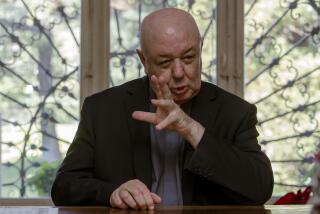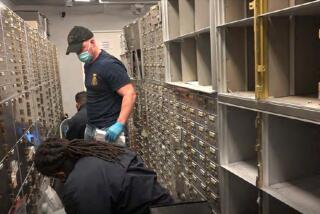Airing out the vaults
Washington â There are home movies of Ronald Reagan as a lifeguard at age 16 and Bill Clinton as a child, and immigration papers from Greta Garbo, Alfred Hitchcock and Secretary of State Colin Powellâs father, Luther.
Thereâs a letter from Walt Disney to President Nixon, on why kids should be Republicans, and the telegram that President Lincoln sent to General Grant urging him not to let rumors of settlement talks between the North and the South âchange, hinder or delay your military movements.â
But the core of a new exhibition at the National Archives in Washington, D.C., is less the novelties of federal holdings than an interactive connection to history. âThe Public Vaults,â which opens today, offers visitors a simulated experience of walking through the stacks of the National Archives by displaying electronic copies of its documents. At its myriad locations, the Archives houses more than 8 billion pieces of paper from the executive, legislative and judicial branches of the federal government; 5 million maps and architectural drawings; 18 million aerial photographs; 35 million still pictures and posters; and electronic records comprising about 4 billion logical data records.
âWe in this country donât have a state religion and we donât have a shared ethnicity,â archivist John W. Carlin said in unveiling the exhibition. âThese documents are our common identity.â
The Archives, which also administers presidential libraries, has always been a fortress on the National Mall. Located in the shadow of the Smithsonian Institution, the Archives building looks formidable, like a stern uncle.
While children scamper and squeal at the nearby Natural History Museum, sober scholars huddle at the Archives, ferreting out documents of arcane origin. Except for the founding documents -- the Declaration of Independence, the Bill of Rights and the U.S. Constitution, proudly on display in the rotunda and viewed by 1 million visitors a year -- the building exudes the feeling of a cold, steel vault.
âRecords that used to be locked away are now where Americans can experience them,â said Thomas Wheeler, president of the Archives Foundation, a private group that has raised $16 million to augment the governmentâs $110 million for the Archivesâ renovation. âWeâre getting those documents out of the vault.â
Now, visitors can eavesdrop on President Kennedy and Joint Chiefs of Staff Chairman Maxwell Taylor as they discuss the merits of various military responses to the 1962 Cuban Missile Crisis. Or see the Bell & Howell Zoomatic camera that Abraham Zapruder used to photograph JFKâs assassination. They can read the evidence compiled for the investigation into the sinking of the Titanic. Or imagine the impact of a âJoin the U.S. Army Air Corpsâ poster. They can marvel at the machine that Nixon secretary Rose Mary Woods used to transcribe the presidentâs taped conversations about Watergate, the one in which her foot inadvertently erased 18 1/2 minutes of the so-called âsmoking gunâ tape. Or they can gaze at a photograph of Nixon with Elvis Presley, and read letters teenagers wrote to the White House urging the government to keep Elvis out of the Army.
In a part of the exhibition devoted to unmasking old government secrets, visitors can peruse the declassified documents amassed in six major incidents in American history.
Among the episodes on display now: the development of the atomic bomb that ended World War II, the Zimmerman telegraph that Woodrow Wilson used to propel the country into World War I, and the case against Julius and Ethel Rosenberg, an American couple convicted of being Soviet spies and put to death.
At any time, more than 1,000 items can be on display. Curators opened the exhibition to military personnel and their families on Veterans Day. Earlier, two Americans whose lives are reflected in the âPublic Vaultsâ were on hand to pose with reminders of their childhoods.
John Beaulieu was a student at the Perkins School for the Blind in Watertown, Mass., Helen Kellerâs alma mater, when he decided to write a letter, in Braille, to President Eisenhower.
The year was 1956, Ike was running for reelection and the 13-year-old Beaulieu suggested a campaign speech along these lines: âVote for me. I will help you out. I will lower the prices and also your tax bill.â
These days Beaulieu works for the IRS in Massachusetts, helping the blind fill out and submit their tax returns. He and his family traveled to Washington for the opening, to see Beaulieuâs letter displayed for the public.
Gina Townsend was 3 years old when she and her mother traveled to Washington to receive the Medal of Honor awarded to her father, Pfc. Clifford Chester Sims, who had been killed in Vietnam.
Sims was leading a squad through dense woods in Hue when he heard the sound of a booby trap triggered in front of his men. He yelled to them to get out and then threw his body on the exploding device, saving their lives and earning a Medal of Honor for heroism âabove and beyond the call of duty.â
She came to Washington to see that her father was one of eight American Medal of Honor winners recognized by the Archives. With her was her brother, Wardell Townsend, and the youngest of her three daughters. Kristin Townsend is 3 years old.
More to Read
The biggest entertainment stories
Get our big stories about Hollywood, film, television, music, arts, culture and more right in your inbox as soon as they publish.
You may occasionally receive promotional content from the Los Angeles Times.










